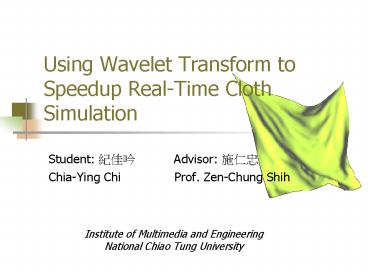Using Wavelet Transform to Speedup RealTime Cloth Simulation - PowerPoint PPT Presentation
1 / 44
Title:
Using Wavelet Transform to Speedup RealTime Cloth Simulation
Description:
Using Wavelet Transform to Speedup Real-Time Cloth Simulation. Student: ??? Advisor: ???. Chia-Ying Chi Prof. Zen-Chung Shih. Institute of Multimedia and Engineering ... – PowerPoint PPT presentation
Number of Views:99
Avg rating:3.0/5.0
Title: Using Wavelet Transform to Speedup RealTime Cloth Simulation
1
Using Wavelet Transform to Speedup Real-Time
Cloth Simulation
- Student ??? Advisor ???
- Chia-Ying Chi Prof. Zen-Chung Shih
- Institute of Multimedia and EngineeringNational
Chiao Tung University
2
Abstract original method
Time t
Time t 1
3
Abstract our method
4
Outline
- Introduction
- Related works
- System overview
- Our Speeding Approach
- Fast and Stable Integrator
- Implementation Results
- Conclusion and Future Works
5
Introduction
6
Introduction
- Regions with low curvature often occur
- Bending forces
- Not always moved in VR environment
- To deal with problems
- Time consuming framework
- Stable simulation
- Our approach
- Pre-processing of segmentation
- Modified integrator
7
Related works
- Mass-spring system
- Adaptive mesh
8
Mass-spring system
9
Adaptive Mesh (multi-level mesh)
10
Mesh adaptation
Choi and Hong using surface wavelet VSMM 2002
v3 refinement rule used by Volkov ACSC 2005
11
Mesh adaptation
- Features
- Construction and destruction (FILO)
- Change mesh topology
- For accurate result mainly when collision occurs
- Segmentation rule
12
Integration method
13
Integration method
- The Verlet method
- Proposed early by Verlet in 1997
- For experiment on fluid
- Desbrun use it for cloth simulation
- Because sometimes position changed rapidly (ex
collision response) - Changed in position directly effect velocities
14
Our Speeding Approach
- Segmentation
- Interpolation
15
Segmentation
- Method requirement
- Fast
- Nodes in the same cluster must be connected
- Not all nodes should be classified into a cluster
16
Wavelet transform
- Used in digital signal processing
- CWT (continuous wavelet transform)
- DWT (discrete wavelet transform)
- The Haar wavelet
- proposed in 1909 by Alfred Haar
- the simplest possible wavelet
- 2D Haar wavelet transform
17
The Haar wavelet transform
?-average-?
?-difference?
18
The Haar wavelet transform
average
difference
19
The Haar wavelet transform
average
difference
20
The Haar wavelet transform
21
Segmentation
Normal differences
Average normal
Vertex normal
Vertex normal
a
b
22
Interpolation
23
Bilinear Interpolation
24
Following benefit (1)
- Over-stretch springs
25
Following benefit (2)
- Over-stretch spring
26
Fast and Stable Integrator
- Explicit/Implicit Euler method
- Approximate implicit method
- our integration method
27
Integration method
- Explicit Euler method
- The oldest and most simple method
- Direct linear extrapolation
v
t-h t th
28
Explicit method
?Error
v
t-h t th
29
Integration method (cont)
- Implicit Euler method (The backward Euler method)
- introduced by Baraff at 1998
- Consider all nodes when calculating each node
- Compute a N?N matrix H for N mass points
- Prediction for the next time step
- Stability is the most advantage
- larger simulation time steps
- Total computation time decreased
30
Implicit method
- ?F/?x is denoted as H
H
If i ?j and i,j is linked
From Desbrun(1999)
31
Integration method
- Approximated implicit method
- Hij0 when node i and node j are not connected
- Compute only non-zero elements
- Desbrun splits the forces into two parts
- the linear one and nonlinear one.
- Cho and Choi makes the model working in O(n)
- simplified the formula of ?v
32
Approximated implicit method
FromChoi and Cho (2000)
33
Verlet integrator
- Calculating position without computing velocities
34
Our integration method
- Modified for our speedup approach
- Ideas from combining Verlet method
- Basically use approximated implicit method
- Not use it to calculate ?v
- To predict velocity for the next time step
- Calculate position use explicit method
- Errors from interpolation should not be propagate
35
Implementation Results
- Simulation
- Stretch correction
- Enhancement
36
Implementation
- Environment
- Pentium 4 PC with 3.4GHz CPU
- 2Gbyte RAM
- NVIDIA GeForce 6600 GT graphic card
- Cloth object
- 3232 and 6464
- Spring constant 2000
37
Result (3232)
38
Result (6464)
39
Over-stretch correction
Original simulation
With our approach
40
Enhancement
- Stability and efficiency enhanced
- Our system can perform simulation at timestep
0.06 - While original method only performs at timestep
no over than 0.023 - That means less simulation frequency and time
costs.
41
Conclusion
42
conclusion
- for simulating cloth in real-time
- a time-saving approach
- a suitable algorithm
- advantage
- Less time for each frame calculation
- Less frequency to simulation
- Higher stability
- Bending and over-stretch correction
43
limitation
- Accuracy is not the point
- interpolation
- Cloth resolution must be 2n
- 2D wavelet transform
44
Future Works
45
Future Works
- Temporal coherence
- No need to rebuild hierarchical structure every
time - Feature vector
- Forces, velocities
- Better interpolation method
- Interpolate smoothly
46
Questions?































